How (Not) to Pick a Plant
February 6, 2014 by admin
Filed under Garden Design, Perennials, Shade Gardening
Over the coming months I’ll be basing a number of blog posts, including this one, on material from my forthcoming book, The Shady Lady’s Guide to Northeast Shade Gardening. The official publication date is May 6, 2014. You can learn more about the book here, here and here.
When you pick perennial plants to put in your shade garden, how do you do it? Most people would start out by picking plants they like—and that’s where they’d make their first, and worst, mistake.
Huh? What? Surely I can’t be advising you to pick out plants you don’t like?! No, of course not. But think about this for a second. When you go shopping for a new car, do you just pick out the one you like the best? No—at least not if you’re like most of us. If that were all it took, we’d all be driving around in Ferraris and Lamborghinis. The problem with that approach is that most sports cars won’t do what most people need a car to do: get up a snowy hill on a winter day and deliver you to your job in one piece, or get enough miles to the gallon to not break the fuel budget.
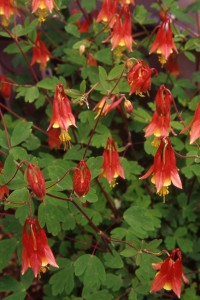
Flowers, flowers, we all like flowers—but there are many other important things to consider when choosing shade perennials.
In other words, we consider practical things. As weird an idea as this will seem to many people, you should do the same thing when you pick out plants—if you want your garden to look good with minimal effort and expense for the longest possible season.
Not all plants are equally good at doing that. In fact, for any given type of garden in any given region, only a small number of plants will give that kind of superior performance, in the same way that, in all likelihood, only a small number of cars will satisfy your criteria for budget and functionality.
So, what are the practical questions you have to ask when picking out plants? First, the more obvious ones:
• Is the plant cold hardy where I live?
• Does the plant prefer the conditions I can offer it?
It’s self-evident why these are questions you should ask first. It makes little sense to populate your perennial garden with plants that won’t be, well, perennial in your area. It also makes little sense to invest in plants that won’t be happy with the growing conditions you provide them. Matching plants to growing conditions is an essential part of the art of garden design. I’m not going to go into detail here about the fine points of that process; what matters is that you realize its importance.
What else do you need to ask yourself in order to pick the best perennials for shade? Here are a few more:
• Is the plant disease resistant?
• Is the plant prone to insect infestation?
• Is the plant unpalatable to deer and other potential browsers?
• Does the plant spread or seed aggressively?
• Does the plant typically go dormant before first frost?
• Does the plant have foliage that looks good all season long?
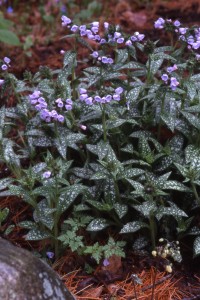
Powdery-mildew resistant Pulmonaria 'Roy Davidson'
The benefits of disease and pest resistance are obvious. Lungworts (Pulmonaria, see photo at left), for example, have unique speckled foliage that can brighten shady nooks and crannies, but most of them are prone to a disfiguring fungal disease called powdery mildew that leaves them coated with an unattractive whitish film. Luckily, some lungworts are resistant. If you buy only the resistant ones, you’ll be able to enjoy the beauty of disease-free lungworts, and you won’t have to expend extra effort to keep them that way.
It’s the same story for all the other questions above. By carefully selecting plants that aren’t palatable to most insect pests and browsing animals, you eliminate the need to take action to stop various critters from nibbling. Likewise, you reduce the need for work (and increase the percentage of your time in the garden devoted to enjoying it) by avoiding overly aggressive spreading plants.
Finally, as a general rule plants that perform well over a long season should be given priority over those that go dormant early or whose foliage declines in quality after flowering. Obviously, we’d all prefer a garden that looks full and good for the longest possible stretch of time.
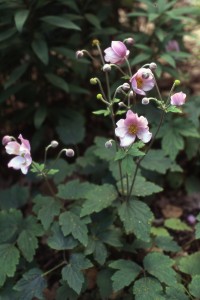
The long-flowering Japanese anemone cultivar 'Robustissima'
• Does the plant have attractive, prominent flowers? (Finally!)
• Do the flowers have a scent that’s nice, objectionable or simply absent?
• Do the flowers last a long time?
And there you have it: questions about flowers are in last place. Now, I want to clarify something. I understand perfectly why so many home gardeners give in to the temptation to fill their properties with plants having beautiful flowers. Beautiful flowers are lovely to look at—it’s as simple as that. The problem is that we don’t live in an ideal world. Flowers fade, and most perennials only produce flowers for two to three weeks every year under the best of circumstances. That’s not very long, so if you pick plants based on how well you like their flowers, you won’t get much bang for your buck.
I’m not saying that you should ignore a plant’s flowers when making choices. For instance, it is true that a small number of perennials will flower for a longer-than-average time, and can be worthwhile making room for these plants in your garden for that simple reason. One example is the Japanese anemone pictured above. I’m just saying that most of the time you should only be considering the flowers of plants that have passed muster in a lot of other ways first. Flowers should be your last consideration, not your first.
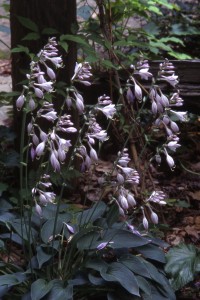
Cut these hosta flowers off? Not me!
In my next blog post, I’ll elaborate a little more on what makes a superior shade perennial and share a few examples.
My New Shade Gardening Book!
February 6, 2014 by admin
Filed under My New Book
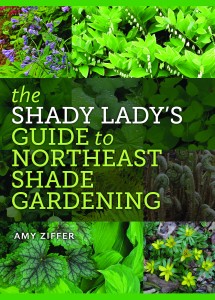 I am happy and proud to announce that my new book, The Shady Lady’s Guide to Northeast Shade Gardening from the University Press of New England is now available at bookstores and is shipping from online retailers!
I am happy and proud to announce that my new book, The Shady Lady’s Guide to Northeast Shade Gardening from the University Press of New England is now available at bookstores and is shipping from online retailers!
If you own a copy and are looking for the supplemental photos promised in the book, you can view the first batch (for Plants for Special Situations, beginning on page 189), by clicking here. Photos of Selected Shrubs (corresponding to text beginning on page 31) are on view here.
In the near future, in response to reader requests, I’ll also be adding a gallery of wider context garden shots to illustrate some of the shade garden design pointers I give.
I’d like to say a heartfelt “thanks” to readers who have posted favorable reviews in cyberspace, as well as to these respected folks, who read the book in the pre-print stage and had some kind words:
“Gardens—and gardeners—are rooted in place, so it’s a good idea to let people know where you’re coming from when you offer advice. Amy Ziffer’s The Shady Lady’s Guide to Northeast Shade Gardening puts it right out front. Hers is no one-size-fits-all tome, but a friendly and informative guide for gardeners who deal with trees, deer and unpredictable weather of the Northeast. Practical, detailed and realistic, Ziffer engagingly conveys the challenges and rewards garnered from years of hands-on gardening and close observation. Her depth of experience and conversational tone make this book the next best thing to being in the garden with her.”
—Karen Bussolini, garden author, photographer, speaker and eco-friendly garden coach
“Every Northeastern gardener needs to read this eyes-wide-open, tell-it-like-it-is book. Even if you don’t have shade now, follow the advice in this book and sections of your garden might someday bask in the shadows of luxuriant bedfellows. Get enlightened.”
—Tovah Martin, author of The Unexpected Houseplant and The New Terrarium.
“If you are tired of watching your lawn fade in the shady areas of your property, or have decided to fill those bare spots under your oak with beautiful perennials, Amy Ziffer can help. In her timely new book, the Shady Lady challenges a common misconception in gardening: that there are very few perennials that thrive in the shade. For gardeners seeking a nondestructive compromise between all native landscapes and those decorated only with exotic ornamentals, The Shady Lady’s Guide to Northeast Shade Gardening is a must read.”
—Douglas W. Tallamy, author of Bringing Nature Home: How You Can Sustain Wildlife with Native Plants.
I wrote the book because I saw a need for a different kind of book about ornamental shade gardening. While much good material has been written about the subject through the years, I saw the existing body of advice as incomplete.
What makes this book different from ones you’ve seen before? First, it’s specifically for gardeners in the Northeast. Because weather, growing conditions, and plant pests and diseases vary so much from region to region, you’ll find the best, most accurate gardening advice close to home. My book talks only about plants we Northeast gardeners can grow, organized to help you narrow down your choices even further by USDA Zone and growing situation.
Second, it takes a unique approach to plant selection and design. I’ve been frustrated by shade gardening books that simply list plants as if all of them were equally good. They’re not. My book evaluates plants based on their performance potential over the whole growing season as well as in specific light levels and under different growing conditions. They’re categorized to help you quickly find the plants most likely to contribute to a rewarding, successful landscape design for your unique property.
I introduce a concept I’ve used in my own design work for years: backbone plants. This is my own term for a select group of plants whose ornamental qualities are so superior to those of the bulk of plants that they should comprise the majority of most shade garden designs. By devoting most of your garden space to backbone plants, you’ll simplify the process of design and increase the chances of having a satisfying garden enormously.
Third, it discusses gardening honestly and frankly, as an endeavor that requires a real commitment of time and energy and has a real ecological impact—potentially good or bad. I strongly encourage increased use of the many fine native plants that have the potential to be superior shade garden performers. Conversely, I warn readers about the possible negative effects of using overly aggressive exotic plants they might one day wish they’d never grown. It’s my hope the book will stimulate a respectful dialogue—one that’s already going on—about whether and how we gardeners should leave a mark on our surroundings.
Thanks for your interest in my book! Here are links to a variety of resources where you can find out more about it and purchase it online (but please don’t forget about your hometown bookseller):
My Author page at the University Press of New England’s website.
My Facebook Author page. Please “Like” my page to help me promote it!
Indigo (Canada)

